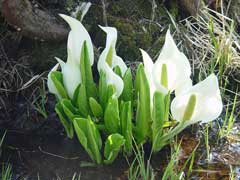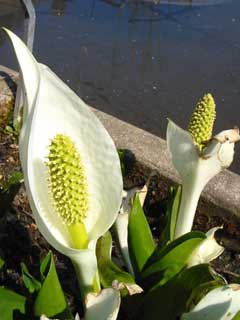 |
|
|
 |
| http://fr.wikipedia.org/wiki/Utilisateur:Bouba |
Translate this page:
Summary
Physical Characteristics

 Lysichiton camtschatcense is a PERENNIAL growing to 0.8 m (2ft 7in) by 0.6 m (2ft).
Lysichiton camtschatcense is a PERENNIAL growing to 0.8 m (2ft 7in) by 0.6 m (2ft).
See above for USDA hardiness. It is hardy to UK zone 6. It is in flower from February to April. The species is hermaphrodite (has both male and female organs) and is pollinated by Insects. The plant is self-fertile.
Suitable for: light (sandy), medium (loamy) and heavy (clay) soils. Suitable pH: mildly acid, neutral and basic (mildly alkaline) soils. It can grow in semi-shade (light woodland) or no shade. It prefers wet soil and can grow in water.
UK Hardiness Map
US Hardiness Map
Synonyms
L. album. L. japonicum.
Plant Habitats
Woodland Garden Dappled Shade; Shady Edge; Ground Cover; Pond; Bog Garden;
Edible Uses
Edible Parts: Leaves Shoots
Edible Uses:
Young shoots - they must be thoroughly cooked otherwise they are poisonous[105].
References More on Edible Uses
Medicinal Uses
Plants For A Future can not take any responsibility for any adverse effects from the use of plants. Always seek advice from a professional before using a plant medicinally.
None known
References More on Medicinal Uses
The Bookshop: Edible Plant Books
Our Latest books on Perennial Plants For Food Forests and Permaculture Gardens in paperback or digital formats.

Edible Tropical Plants
Food Forest Plants for Hotter Conditions: 250+ Plants For Tropical Food Forests & Permaculture Gardens.
More

Edible Temperate Plants
Plants for Your Food Forest: 500 Plants for Temperate Food Forests & Permaculture Gardens.
More

More Books
PFAF have eight books available in paperback and digital formats. Browse the shop for more information.
Shop Now
Other Uses
The plants have very large leaves and form a slowly spreading clump. They can be grown as a ground cover, spaced about 1 metre apart each way[208].
Special Uses
Ground cover Scented Plants
References More on Other Uses
Cultivation details
Requires a wet or damp humus-rich soil in full sun or semi-shade[200]. Grows well by water or in the bog garden[1]. Succeeds in shallow water. Hardy to about -15°c[200] Young plants require protection from slugs[187]. Plants are slow to establish at first, taking some years, but they can then become naturalized and self-sow[208]. The flowers are sweetly scented according to one report[187], whilst another says that the plant emits an unpleasant animal smell[245]. Hybridizes with L. americanus[200].
References Carbon Farming Information and Carbon Sequestration Information
Temperature Converter
Type a value in the Celsius field to convert the value to Fahrenheit:
Fahrenheit:
The PFAF Bookshop
Plants For A Future have a number of books available in paperback and digital form. Book titles include Edible Plants, Edible Perennials, Edible Trees,Edible Shrubs, Woodland Gardening, and Temperate Food Forest Plants. Our new book is Food Forest Plants For Hotter Conditions (Tropical and Sub-Tropical).
Shop Now
Plant Propagation
The seed is best sown as soon as it is ripe in pots in a cold frame[134]. Keep very moist, preferably by emmersing the pot in 2 -3 cm of water[200]. Germination is usually good, taking place within 1 - 2 months at 15°c[134]. When they are large enough to handle, prick the seedlings out into individual pots and grow them on in trays of water in the greenhouse for at least their first winter. Plant them out into their permanent positions in late spring or early summer, after the last expected frosts. Division in the middle of autumn or mid to late winter, but no later than this because the plant will be coming into growth.
Other Names
If available other names are mentioned here
Native Range
Coming Soon
Weed Potential
Right plant wrong place. We are currently updating this section.
Please note that a plant may be invasive in one area but may not in your area so it's worth checking.
Conservation Status
IUCN Red List of Threatened Plants Status :

Growth: S = slow M = medium F = fast. Soil: L = light (sandy) M = medium H = heavy (clay). pH: A = acid N = neutral B = basic (alkaline). Shade: F = full shade S = semi-shade N = no shade. Moisture: D = dry M = Moist We = wet Wa = water.
Now available:
Food Forest Plants for Mediterranean Conditions
350+ Perennial Plants For Mediterranean and Drier Food Forests and Permaculture Gardens.
[Paperback and eBook]
This is the third in Plants For A Future's series of plant guides for food forests tailored to
specific climate zones. Following volumes on temperate and tropical ecosystems, this book focuses
on species suited to Mediterranean conditions—regions with hot, dry summers and cool, wet winters,
often facing the added challenge of climate change.
Read More
Expert comment
Author
(L.)Schott.
Botanical References
58200
Links / References
For a list of references used on this page please go here
Readers comment
| Add a comment |
|
If you have important information about this plant that may help other users please add a comment or link below. Only comments or links that are felt to be directly relevant to a plant will be included. If you think a comment/link or information contained on this page is inaccurate or misleading we would welcome your feedback at [email protected]. If you have questions about a plant please use the Forum on this website as we do not have the resources to answer questions ourselves.
* Please note: the comments by website users are not necessarily those held by PFAF and may give misleading or inaccurate information.
To leave a comment please Register or login here All comments need to be approved so will not appear immediately.
|
Subject : Lysichiton camtschatcense
|
|
|
|